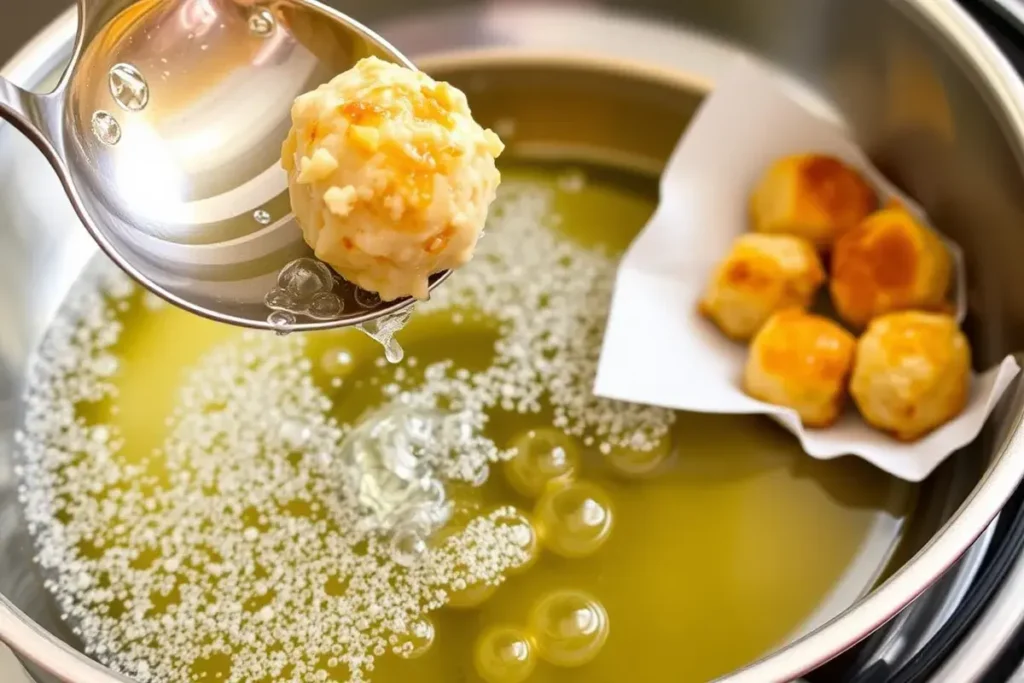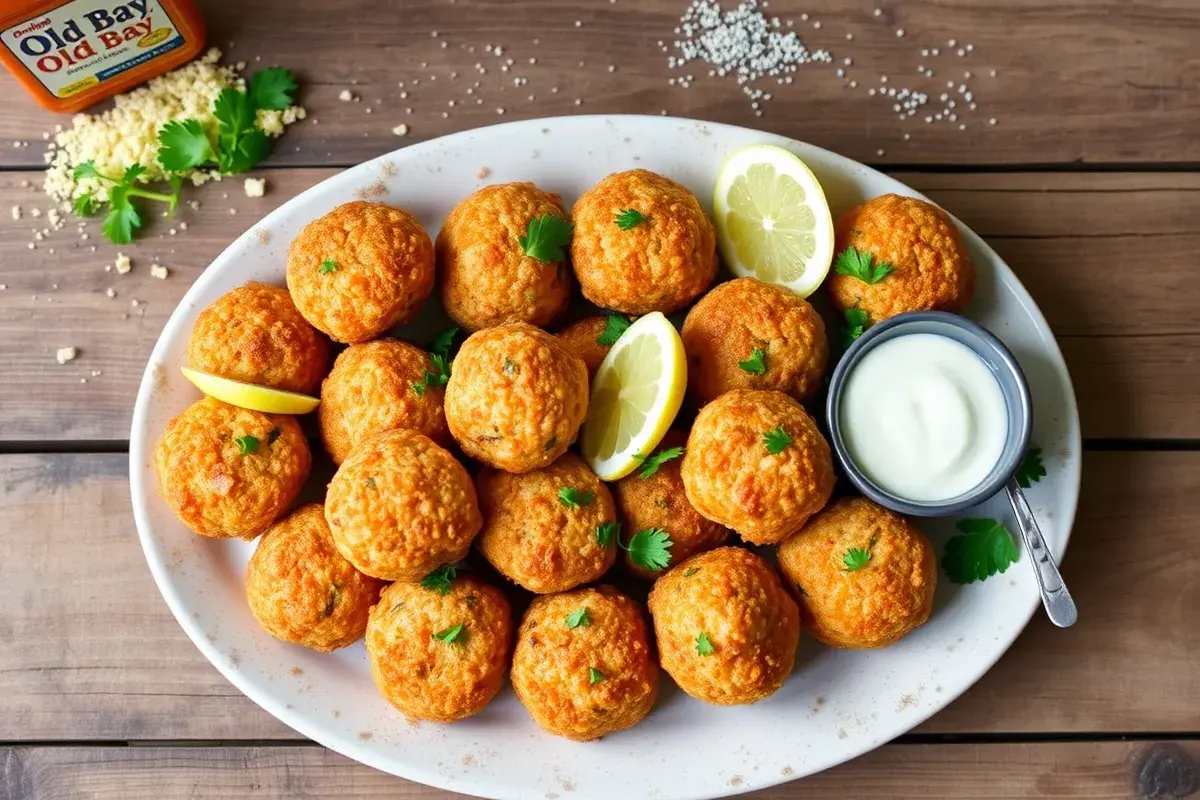Crab lovers worldwide rave about crab balls because they’re a bite-sized way to savor the ocean’s bounty. These small, flavorful morsels celebrate the rich taste of crab, enhanced by a perfect balance of complementary ingredients. However, achieving a crispy exterior and tender interior requires careful attention. Therefore, this guide will equip you with everything you need to know—from selecting the right type of crab meat to storing your creations correctly.
In this comprehensive article, you’ll discover the origins of this beloved snack, key cooking techniques, and creative twists you can try at home. Above all, you’ll learn about the fascinating ways these seafood delights can become a focal point at any gathering. Prepare to delve deep into the world of sweet crab goodness and master the art of creating a memorable, mouthwatering treat!
A Brief History of Crab Balls
Crab is one of the most prized treasures of the sea. Centuries before refrigeration, coastal dwellers cherished crab as an affordable and abundant protein source. As seafood recipes evolved, crab balls made their entrance as a way to stretch limited resources while still celebrating the crab’s natural sweetness.
Origins and Early Usage
In coastal regions around the world, people concocted various forms of crab-based dishes. For example, early recipes in the Chesapeake Bay area often used leftover crab meat combined with breadcrumbs and spices. These creations eventually morphed into items such as crab cakes, croquettes, and, later on, crab balls. Indeed, the concept of mixing crab meat with a starch or binder has been around for centuries. Consequently, each region put its own spin on this versatile ingredient, culminating in a unique, bite-sized form that many now enjoy.
Why Crab Balls?
Crab balls offer several advantages:
- Portability: They’re easy to handle and serve, making them ideal for parties.
- Flavor Concentration: The compact size highlights the crab’s natural sweetness.
- Versatility: You can bake, fry, or even grill them, all with minimal fuss.
Above all, this versatile seafood dish appeals to home cooks and professional chefs alike for its simplicity. It can quickly transform into either a standalone entrée or a show-stopping appetizer. Moreover, cooking methods continue to expand as modern recipes embrace influences from global cuisines.
Crab Balls vs. Crab Cakes
Both crab balls and crab cakes share a crucial commonality: They celebrate fresh crab meat. However, subtle differences in preparation and presentation set them apart.
Shape and Size
Traditional crab cakes are generally shaped into small patties. On the other hand, crab balls take the form of smaller spheres—typically bite-sized or slightly larger. Because of their rounded shape, they often have a crispier exterior when fried.
Cooking Techniques
Crab cakes are often pan-seared or baked. These smaller spheres, however, are more frequently deep-fried, although baking them is also popular. This difference in cooking method influences the texture: fried versions tend to be crispier, while baked ones develop a more subtle golden crust.
Serving Styles
- Appetizers: Perfect for buffets and finger food at gatherings.
- Main Dishes: Larger crab cakes often assume the spotlight on a dinner plate.
- Versatility: You can enjoy both in sliders, atop salads, or as part of a seafood platter.
Therefore, choosing between these morsels or traditional patties often depends on the occasion. For appetizers or party snacks, the bite-sized option is a foolproof choice. Conversely, if you desire a hearty portion, a standard crab cake may be more appropriate.
Essential Ingredients for the Perfect Crab Balls
Creating impeccable results depends on a blend of fresh seafood and strategic seasonings. In many respects, high-quality crab meat is the star ingredient; however, supporting cast members—from breadcrumbs to spices—also play a vital role in ensuring a superior taste and texture.
Crab Meat Selections
Different types of crab meat add distinct flavors. Therefore, choosing the right meat is critical. Common varieties include:
- Lump Crab Meat: Provides sizable chunks and a delicate flavor.
- Backfin Crab Meat: Consists of smaller flakes and lumps, mixing well with binders.
- Claw Crab Meat: Darker and more robust in flavor, often less expensive.
If you aim for a premium texture, lump crab meat stands out. Nonetheless, combining lump with claw meat can yield a more budget-friendly option without sacrificing taste.
Binders and Fillers
These little seafood bites need a reliable binder to hold their shape. Breadcrumbs, crushed crackers, or panko are frequently used for this purpose. However, it’s important to use just enough to keep the mixture together without overpowering the crab flavor. Eggs are also integral as they help unify everything.
Typical binders and fillers include:
- Breadcrumbs or Panko: Offers structure and a subtle crunch.
- Eggs: Ensures the crab meat stays intact.
- Mayo or Mustard: Adds creaminess and tang, bolstering flavor.
Flavor Enhancers
Subtle seasonings and aromatics can make your mixture truly memorable. You don’t need an avalanche of flavors—often, a few well-chosen spices can highlight the crab’s natural sweetness. For example, Old Bay seasoning remains a classic option. Meanwhile, fresh herbs like parsley or chives can lend a bright accent.
Some popular flavor enhancers:
- Old Bay Seasoning: A time-honored seafood staple.
- Garlic Powder: Adds mild pungency.
- Onion Powder: Provides a soft, savory depth.
- Cayenne Pepper: Instills gentle heat for those who enjoy a kick.
Step-by-Step Cooking Methods for Crab Balls

Although these spheres typically follow a straightforward cooking process, multiple methods exist to accommodate personal preferences and dietary needs. Indeed, you can deep-fry, pan-fry, bake, or even air-fry them. Therefore, understanding each technique helps you pick the approach that best suits your kitchen setup and desired level of crispiness.
1. Deep-Frying
Deep-frying yields crunchy, golden-brown results. For best results, use an oil with a high smoke point, like peanut or vegetable oil.
How to Deep-Fry:
- Heat oil in a deep fryer or heavy-bottomed pot to about 350°F (175°C).
- Carefully place the shaped mixture into the hot oil using a slotted spoon.
- Fry until golden brown, usually 3–4 minutes.
- Remove and drain on paper towels. Season with a pinch of salt.
Tip: Avoid overcrowding the pot. Doing so can lower the oil temperature and result in oily or undercooked results.
2. Pan-Frying
Pan-frying offers a slightly lighter alternative. Use enough oil to cover about half of each piece to achieve crisp edges.
Steps to Pan-Fry:
- Heat oil in a skillet over medium-high heat.
- Gently place the spheres in the pan, leaving space between them.
- Cook for 2–3 minutes per side or until golden brown.
- Drain on paper towels and serve warm.
Because you use less oil, the texture might be less crunchy but still delicious. Furthermore, controlling the heat is easier when pan-frying, and the cleanup is simpler.
3. Baking
Baking provides a healthier choice. Although the exterior won’t be as crisp, the finished product still develops a pleasant texture.
Baking Instructions:
- Preheat oven to 375°F (190°C).
- Arrange your formed pieces on a greased baking sheet.
- Lightly brush each one with oil or melted butter.
- Bake for 15–20 minutes, flipping halfway through.
- Finish under the broiler for 1–2 minutes if extra browning is desired.
Therefore, for those aiming to reduce fat, baking is a commendable option that retains much of the crab’s delicate taste.
4. Air-Frying
An air fryer can simulate deep-frying with minimal oil. In fact, this method delivers a crispy exterior while keeping the interior moist.
Air-Fryer Method:
- Preheat air fryer to 375°F (190°C).
- Lightly spray each piece with cooking spray.
- Cook for 10–12 minutes, turning once halfway.
- Watch for an even, golden surface and serve hot.
With modern kitchen gadgets, air-frying is a convenient method, especially for those with dietary concerns. This approach uses less oil while still imparting a delightful crunch.
Flavor Profiles and Seasoning Tips of crab balls
These bite-sized treats typically taste sweet and savory, with the natural brininess of crab at the forefront. However, seasoning plays a vital role in enhancing these flavors. Consequently, many cooks experiment with various herbs, spices, and sauces to achieve a personalized twist.
Balancing Sweet and Savory
A small pinch of sugar can heighten the crab’s sweetness, although it’s not mandatory. For a bolder taste, add soy sauce, Worcestershire sauce, or a dab of mustard. Nonetheless, proceed with caution—overpowering the delicate seafood can lead to a muddled flavor profile.
Herbs and Spices
- Old Bay: A perennial favorite for all things crab.
- Paprika or Smoked Paprika: Contributes color and complexity.
- Fresh Herbs: Chives, dill, and parsley add lively green notes.
- Cumin: Offers an earthy depth when used sparingly.
Therefore, customizing your flavor arsenal empowers you to craft morsels that cater to your palate. For example, if you love heat, toss in a dash of chili flakes or a minced jalapeño for a spicy kick.
Dips and Sauces
Tartare sauce, cocktail sauce, and spicy aioli each complement the briny flavors of crab. Moreover, a simple squeeze of lemon can brighten the entire dish. By pairing your creation with well-chosen dips, you amplify the overall culinary experience.
Different Variations of Crab Balls

Though typically made with standard seasonings and breading, you can infuse these bites with global ingredients to create innovative twists. After all, crab is a neutral enough canvas to welcome various spices and accompaniments.
Cajun-Style
For a Southern-inspired flair, incorporate Cajun seasoning, chopped bell peppers, and extra chili powder into your mixture. Pan-fry these to achieve a crisp outer layer. Serve them with spicy remoulade sauce for a tangy complement.
Asian-Inspired
If you crave an umami boost, add soy sauce, sesame oil, and minced ginger. You could even blend in a pinch of wasabi for a subtle zing. Present them with a miso-based dipping sauce or a ginger-soy glaze for a vibrant, fusion-style appetizer.
Mediterranean Flair
Combine crab meat with olives, sun-dried tomatoes, and fresh basil. Then, coat each ball lightly with panko. Drizzle them with olive oil before baking to maintain a healthier profile. A lemon-garlic aioli pairs wonderfully with this Mediterranean-inspired version.
Keto-Friendly Option
For low-carb diets, swap breadcrumbs with almond flour or crushed pork rinds. Add a bit of cheese for extra binding, if desired. Air-frying or baking remain optimal choices for keeping the carb count in check. This approach ensures you still relish the indulgent flavor of crab without breaking dietary rules.
Serving Suggestions for Crab Balls
These seafood bites can flourish in multiple dining scenarios, from casual gatherings to upscale events. By carefully selecting serving options, you’ll enhance the overall experience and leave a lasting impression on your guests.
Party Platters
Arrange them on a large platter with assorted dipping sauces. Place garnishes—like lemon wedges, chopped parsley, or sliced jalapeños—around the edges for visual appeal. Consequently, the arrangement becomes both attractive and convenient for guests.
Hors d’Oeuvres
When serving as hors d’oeuvres, consider using small skewers or toothpicks. That way, guests can grab each piece more easily. Additionally, spacing them out on a decorative tray helps keep them warm and crispy.
Main Course Option
Sometimes these seafood spheres can occupy center stage on a dinner plate. Pair them with a side salad or roasted vegetables. Because of their portability, you can also pile them into a sandwich with lettuce, tomatoes, and a tangy sauce, akin to a crab po’ boy slider.
Picnic or Potluck
Baked or air-fried versions travel well. To keep them fresh, place them in an insulated container. As a result, you’ll retain heat while preventing sogginess. Pack a small container of sauce separately, and let your fellow diners dip at will.
Pairing Crab Balls with Tasty Side Dishes
Choosing the right side dish can transform an ordinary meal into a gourmet experience. Since these crispy treats offer subtle sweetness, pairing them with bright, refreshing sides will complement each bite.
Crisp Salads
- Coleslaw: Creamy coleslaw adds a tangy crunch that contrasts with fried seafood.
- Mixed Greens: A simple vinaigrette can cleanse the palate and offset the richness.
Grains and Starches
- French Fries: A classic duo—enjoy the interplay between salty fries and sweet crab.
- Roasted Potatoes: Garlic-and-herb roasted wedges hold up well next to succulent seafood.
Roasted Vegetables
- Asparagus: When lightly drizzled with olive oil and lemon, asparagus provides a bright flavor.
- Zucchini and Squash: Soft, roasted vegetables balance the crispness of fried bites.
Sauces and Condiments
- Cocktail Sauce: Adds tangy and slightly spicy notes.
- Aioli: Creamy garlic aioli brings a pleasant richness without overpowering the crab.
- Salsa or Pico de Gallo: Offers a fresh, acidic pop that complements the brininess of crab.
Therefore, integrating fresh flavors alongside fried or baked seafood ensures a harmonious meal. Most importantly, select side dishes that elevate—rather than mask—the star ingredient.
Maintaining Freshness: How to Store Crab Balls
Preserving the quality of your finished product once it’s cooked can be a concern. Improper storage leads to soggy exteriors and potential bacterial growth. Hence, follow these tips to keep any leftovers as fresh and appetizing as possible.
Short-Term Storage
If you plan to consume the leftovers within a day or two, store them in an airtight container lined with paper towels. The paper towels absorb excess moisture, preserving the texture of the crust. Set your refrigerator to around 40°F (4°C). Warm them in the oven or an air fryer before serving to restore crispness.
Freezing Guidelines
For longer storage, freeze the prepared bites in a single layer on a baking sheet until they turn solid. Afterward, transfer them to freezer-safe bags, removing as much air as possible. This method, known as flash-freezing, helps maintain shape and flavor. Frozen portions can last up to three months without significant loss of quality.
Reheating Methods
- Oven: Preheat to 350°F (175°C). Spread them on a baking sheet and warm for 10–15 minutes.
- Air Fryer: Heat at 350°F (175°C) for approximately 5–7 minutes.
- Microwave: Not recommended, as it can make them soggy.
Therefore, thoughtful storage and careful reheating will keep your seafood bites just as inviting as when they first came out of the fryer or oven.
Health Benefits of Crab Balls
Although fried foods sometimes carry a reputation for being high in fat, these snacks can still provide nutritious benefits, especially if prepared thoughtfully. First and foremost, crab meat itself offers valuable nutrients, including vitamins, minerals, and lean protein.
Nutritional Profile of Crab
Crab is rich in:
- Protein: Helps maintain muscle mass and repair tissues.
- Omega-3 Fatty Acids: Supports heart health and cognitive function.
- Vitamin B12: Essential for proper brain function and energy production.
- Minerals: Contains iron, zinc, and selenium, contributing to overall wellness.
Health-Conscious Preparations
- Baking or Air-Frying: Reduces oil usage and lowers calorie content.
- Using Whole-Wheat Breadcrumbs: Boosts fiber intake.
- Limiting Heavy Sauces: Cuts unnecessary fats and sugars.
Above all, portion control remains key. While these delights are small, it’s easy to overindulge if they’re exceptionally tasty. Consequently, balancing your meal with vegetables and healthy grains keeps your diet on track.
FAQ Section: Crab Balls
Below are common questions people ask about crab balls, along with detailed answers to guide your culinary journey.
1. What are crab balls made of?
Crab balls typically consist of fresh crab meat, a binder like breadcrumbs or panko, and seasonings such as Old Bay, parsley, and garlic powder. Eggs usually help hold everything together. Some recipes include mayonnaise or mustard for extra moisture and tang.
2. What kind of crabs make little balls?
In nature, certain sand crabs or fiddler crabs roll sand into little balls when they dig or feed on plankton. These balls are not edible but rather a byproduct of their burrowing activity. For recipes, chefs use crab meat from commonly harvested species like blue crabs, Dungeness crabs, or snow crabs.
3. What makes crab cakes stick together?
Binders like eggs and breadcrumbs ensure crab mixtures hold their shape. When forming crab cakes or crab balls, it helps to gently press the mixture together. Overmixing can lead to a dense texture, so aim for a cohesive yet tender structure that maintains the meat’s natural flakiness.
4. Are crab balls good for you?
Yes, crab balls can be nutritious, especially if made with minimal fillers and healthy cooking methods like baking or air-frying. Crab meat provides lean protein, omega-3 fatty acids, and various vitamins and minerals. Nonetheless, keep an eye on portion sizes and added fats from frying or sauces.
Conclusion: Crab Balls for Every Occasion
Whether you’re planning a family dinner, impressing guests at a cocktail party, or craving a simple seafood treat, crab balls stand ready to delight. From their humble origins to today’s innovative fusion variations, these bite-sized wonders offer a dynamic culinary experience. By selecting fresh crab meat, balancing flavors, and choosing a suitable cooking technique, you’ll craft a final product that exceeds expectations. Most importantly, don’t shy away from experimenting with seasonings and sides, because this dish is versatile and ever-evolving. May your next batch be golden, succulent, and unforgettable!

